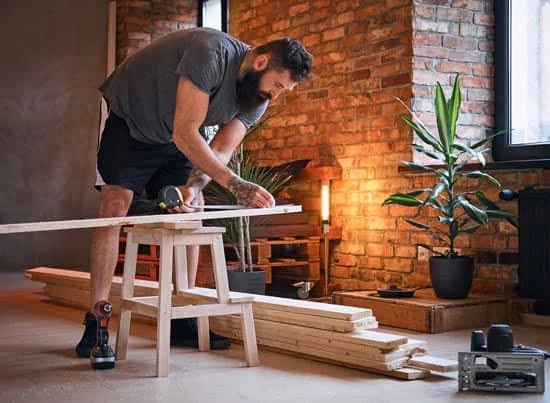Are you curious about how much does it cost to start woodworking and join the ranks of skilled crafters and artisans? Woodworking has an enduring appeal, whether as a hobby or a business venture. The thought of creating custom furniture, intricate carvings, or unique decor pieces can be enticing for many individuals.
In this article, we will explore the costs associated with starting a woodworking journey, from basic tools to workspace setup, materials needed, safety equipment, education and training, budgeting tips, and additional expenses. Whether you are looking to pursue woodworking as a passion project or establish a small business around it, understanding the initial investment required is essential.
For those who are new to woodworking or considering taking it up as a hobby or potential business opportunity, this comprehensive guide aims to provide a clear picture of the financial commitment involved in getting started. From understanding the various tools and equipment needed to creating a realistic budget and making informed purchasing decisions, we’ll walk you through the process of determining how much does it cost to start woodworking.
So let’s delve into the world of woodworking and discover what it takes to turn your creative visions into reality.
Basic Tools
When starting woodworking, one of the most important aspects to consider is the tools needed to bring your projects to life. There are essential hand tools and power tools that every woodworker should have in their arsenal, and knowing the cost and options available is crucial for beginners and intermediate woodworkers alike.
Hand Tools
Hand tools are essential for woodworking, as they allow for precision and control when working with wood. Basic hand tools such as chisels, hand saws, hammers, screwdrivers, measuring tape, and clamps are necessary for any woodworking project. These hand tools can range in price depending on the brand, quality, and materials used. For those on a budget, there are affordable starter sets available that include a variety of essential hand tools.
Power Tools
Power tools are another essential aspect of woodworking, as they can make tasks faster and more efficient. Basic power tools such as a cordless drill, circular saw, jigsaw, sander, and router are commonly used by woodworkers.
The cost of power tools can vary greatly depending on whether you choose corded or cordless options, as well as the brand and quality of the tool. For beginner woodworkers looking to save money, there are entry-level power tool sets available that offer a selection of basic power tools at an affordable price.
Options for Both Beginner and Intermediate Woodworkers
Whether you’re just starting out or have some experience in woodworking, there are options available for every budget. Many reputable brands offer beginner-friendly tool sets at an affordable price point without compromising on quality.
For intermediate woodworkers looking to upgrade their tools or invest in higher-quality equipment, there are various professional-grade options available to suit different preferences and budgets. Knowing what’s essential for your skill level will help you prioritize your purchases and work within your budget.
Workspace
When starting woodworking, having a dedicated workspace is essential for carrying out projects efficiently and safely. The type of workspace needed can vary depending on the scale and nature of the woodworking activities. This might range from using a section of a garage, shed, or basement to setting up a small shop. The cost involved in setting up a functional woodworking area will depend on various factors including location, size, and available resources.
For those with ample space, utilizing an existing area such as a garage or basement can be a cost-effective option for creating a woodworking workspace. However, this might still require some investment in organizing tools and materials, as well as improving lighting and ventilation.
Meanwhile, those with limited space may need to consider investing in sheds or small workshops specifically designed for woodworking. These prefabricated structures come with an array of features suitable for woodworking needs but can increase the initial costs significantly.
According to industry estimates, the average cost of setting up a dedicated woodworking workspace ranges from $500 to $5000 depending on the scale of the operation and whether existing structures are repurposed or new ones are built. Costs include insulation, heating or cooling systems if needed, lighting fixtures, electrical work (for powering tools), workbenches, storage solutions, and dust collection systems among others.
| Workspace Setup Item | Average Cost Range |
|---|---|
| Insulation & Ventilation | $200 – $1000 |
| Lighting Fixtures | $50 – $300 |
| Workbenches | $100 – $500 |
| Dust Collection Systems | $200 – $1000 |
Materials
When starting out in woodworking, one of the most significant considerations is the cost of materials. Lumber, hardware, and other materials can quickly add up, especially for larger or more complex projects. It’s essential to factor these expenses into your overall budget when planning to start woodworking.
Cost of Lumber
The cost of lumber can vary widely depending on factors such as wood species, quality, and size. Hardwoods tend to be more expensive than softwoods, and specialty woods may come with an even higher price tag. To save money, consider purchasing dimensional lumber or using reclaimed wood for your projects. Additionally, buying in bulk or building relationships with local suppliers can often result in discounts or better pricing.
Hardware and Other Materials
In addition to lumber, woodworking projects require various hardware items such as screws, nails, hinges, and fasteners. These costs can also add up quickly, so it’s important to shop around for the best deals. Consider buying in bulk or investing in a variety pack of commonly used hardware to save money in the long run. Other materials like glue, sandpaper, finishes, and specialized tools should also be factored into your initial woodworking budget.
Finding Quality Materials at an Affordable Price
Quality materials are essential for successful woodworking projects, but finding them at an affordable price can sometimes be a challenge. One way to save money is to source materials from local lumber yards or specialty stores instead of large home improvement chains. Keep an eye out for sales and promotions on lumber and hardware items as well. Another option is to join a woodworking club or community where members may have access to group buys or discounted rates on materials.
Considering the cost of lumber, hardware, and other materials is crucial when determining how much it will cost to start woodworking. By exploring different options for sourcing these items at a reasonable price while maintaining quality standards, you can effectively manage this aspect of your woodworking budget.
Safety Equipment
When starting woodworking, it’s crucial to prioritize safety. Investing in the right safety equipment is essential to protect yourself from potential hazards while working with wood. Here are some must-have safety gear that every woodworker should consider purchasing:
- Goggles: Protect your eyes from flying debris, sawdust, and other potential hazards with a pair of high-quality safety goggles. Prices for basic goggles can range from $10 to $30, while more advanced options with anti-fog or anti-scratch features may cost closer to $50.
- Respirators: Woodworking produces a significant amount of sawdust and fine particles that can be harmful when inhaled. A quality respirator can range anywhere from $20 for a basic model to $100 or more for a respirator with replaceable filters and additional comfort features.
- Hearing Protection: Constant exposure to loud power tools and machinery can lead to long-term hearing damage. Invest in a pair of ear muffs or ear plugs, which typically start at around $15 for basic models and can go up to $50 for advanced noise-canceling options.
Aside from these essential safety items, it’s also important to consider other protective gear such as gloves, aprons, and dust masks depending on the nature of your woodworking projects. Keep in mind that while there is a cost associated with acquiring these safety items, they are invaluable investments in your long-term health and well-being.
Finally, don’t overlook the importance of proper training on how to use safety equipment effectively. Many accidents in woodworking occur due to improper use or neglect of safety gear. Therefore, it’s essential not only to invest in the gear but also take the time to learn how to use them correctly through educational resources or classes.
With this information in hand, aspiring woodworkers will have a good understanding of how much they may need to budget when investing in essential safety gear before embarking on their new hobby or business venture. Remember that the overall cost largely depends on individual preferences and the level of quality desired in each piece of equipment. Overall, prioritizing safety is priceless when it comes to the art of woodworking.
Education and Training
Woodworking is an intricate and valuable craft, but it requires a certain level of skill to excel in. For beginners, getting essential knowledge about basic woodworking techniques is crucial to kickstart their woodworking journey. Taking classes or workshops, either in-person or online, can provide the education and training necessary to develop these fundamental skills.
In-person woodworking classes and workshops can cost anywhere from $100 to $600 for a full day or weekend session. These classes often cover a variety of topics including tool usage, safety practices, different types of joinery and construction methods, as well as finishing techniques. The cost may also include materials and the use of equipment during the class.
Another option for individuals interested in learning woodworking basics is online resources such as video tutorials, e-courses, and digital woodworking programs. Online classes typically have more affordable pricing options than in-person events. Some platforms offer monthly subscriptions for access to multiple courses within an entire library of content or specific one-time purchase prices per course or module.
Many beginners find it beneficial to learn from both in-person experiences and online resources for a comprehensive understanding of basic woodworking techniques-but it’s essential for budding woodworkers to weigh the associated costs before investing time and money into educational opportunities.
| Training Option | Cost Range |
|---|---|
| In-Person Classes/Workshops | $100 – $600 |
| Online Resources | Varies (monthly subscriptions or one-time purchases) |
Budgeting Tips
When considering starting woodworking as a hobby or a potential business venture, one of the first things that comes to mind is how much does it cost to start woodworking? The truth is that the cost of starting out in woodworking can vary greatly depending on several factors such as the tools and materials you choose, your workspace setup, and safety equipment. However, with some careful planning and budgeting, it is possible to get started without breaking the bank.
To help you create a budget for woodworking startup costs, here are some practical tips to keep in mind:
1. Research and prioritize essential tools: Make a list of the basic hand tools and power tools needed for your specific woodworking projects. Look for beginner-friendly options that offer good quality without the high price tag. Consider buying second-hand tools in good condition to save money.
2. Find affordable workspace solutions: Depending on your living situation and available space, explore different options for setting up a dedicated woodworking area. This could be a corner of your garage, a shed in your backyard, or even a small rented workshop space. Compare costs and consider DIY solutions to keep expenses down.
3. Source materials wisely: Research local lumberyards and hardware stores to find quality wood and materials at reasonable prices. Look for discounts on bulk purchases or choose alternative wood species that are more affordable but still suitable for your projects.
By taking these budgeting tips into account and being mindful of your spending, it is possible to control how much you spend when starting out in woodworking while still acquiring all the essentials necessary to begin creating beautiful wood pieces. With smart planning, you can build up your collection of tools and materials over time as you gain experience in this fulfilling craft.
Additional Costs
In conclusion, starting a woodworking venture or hobby can be an exciting and fulfilling endeavor for those who have a passion for working with wood. The appeal of creating custom pieces and the potential to turn it into a business makes it an attractive option for many individuals. However, one of the most common questions asked when considering this new venture is “how much does it cost to start woodworking?”.
As outlined in this article, the initial investment in basic tools, workspace setup, materials, safety equipment, education and training, as well as budgeting for additional costs, are all factors to consider when estimating the startup expenses of woodworking. It’s important to recognize that while there may be some upfront costs involved in getting started, with careful planning and budgeting, it is possible to manage these expenses and make informed decisions about where to allocate resources.
Ultimately, the investment required to start woodworking will vary depending on individual circumstances and goals. While some may choose to start small with basic tools and minimal space, others might opt for a larger initial investment in higher quality equipment and dedicated workshop areas.
By taking into account all the factors discussed in this article and doing thorough research on pricing options for tools, materials, education, and other necessities, aspiring woodworkers can make informed decisions that align with their budget and aspirations in the craft.
Frequently Asked Questions
Is Woodworking an Expensive Hobby?
Woodworking can be an expensive hobby, especially when you factor in the cost of tools, materials, and supplies. Quality hardwoods and specialty tools can really add up, making it a costly pursuit for some.
Is It Worth Starting a Woodworking Business?
Starting a woodworking business can be worth it if you have the skills, passion, and determination to make it successful. With the right marketing, quality craftsmanship, and a niche market, woodworking can definitely be a profitable venture.
How Profitable Is Woodworking?
The profitability of woodworking ultimately depends on various factors such as the demand for your products, your pricing strategy, and your ability to manage costs effectively. Some woodworkers find it to be very profitable, while others struggle to make a decent income from it.

Hi everyone! I’m a woodworker and blogger, and this is my woodworking blog. In my blog, I share tips and tricks for woodworkers of all skill levels, as well as project ideas that you can try yourself.





